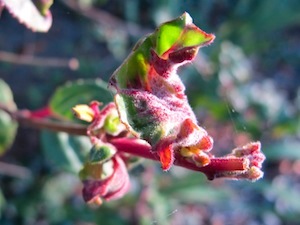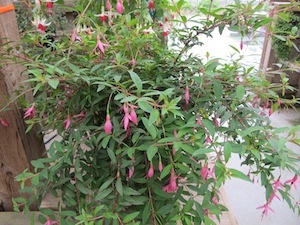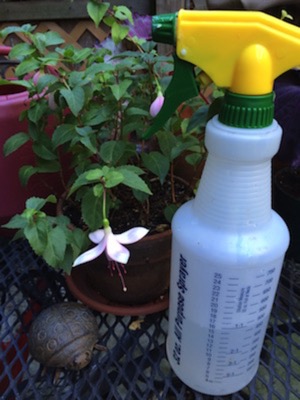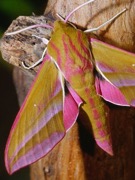
Care & Culture—A Guide to Growing Fuchsias
Doctor! Doctor! There's something's eating at my fuchsias!
Doctor! Doctor! There's something's eating at my fuchsias!
Looking out for those nasty pests & diseases
Aphids – Also greenfly or blackfly. Various Aphis species can do damage to fuchsias with their feeding, especially at the tips of branches, or can encourage the growth of diseases developing on their sugary secretions. A number of low-key or organic methods, including predation by lacewings, ladybugs (ladybirds) and parasitic wasps, and even simple sprays of water, are often very effective. Additionally, insecticidal soaps or chemical controls might be used.
Bees & Hummingbirds – It might seem odd to include a reference to Bees & Hummingbirds in a list of Pests & Diseases, but some birds, including surprisingly some hummingbirds, and several kinds of bees will sometimes bore into the base of flower buds at the nectary to prematurely collect nectar just before the buds open. The odd phenomenon is called “nectar-robbing” has been observed occurring on Fuchsia magellanica in the Tierra del Fuego, as well, and even been the subject of a scientific investigation into its possible effect on that species. Since the normal mutualism between plant and pollinator seems broken by the cheaters, scientists, including even Charles Darwin himself, have assumed that nectar-robbing always had a negative impact on the affected plant species. However, a number of recent studies seem to indicate that the robbery usually has a generally neutral, or even a positive, effect on the reproductive strategies of plants. Other than a slight disfiguration from the small hole where the flower has been pierced, fuchsia nectar-robbing by hummingbirds or bees seems to have no discernible effect on the subsequent opening and fertility of fuchsia blossoms and fruit set.
Blackfly – See Aphids.
Botrytis – Botrytis, or gray mold (grey mould), can be a problem on fuchsias grown in dark and cold conditions or on the inside of dense plants. A plant parasite, it produces a fluffy gray mold. The infection often starts where leaves have collected in moist leaf axils and subsequently moves into the adjoining stems. Potassium bicarbonate-based fungicide has been proven effective as a simple cure and prevention for botrytis as well as a number other plant diseases, such as powdery mildew, blackspot, downy mildew, blights, and assorted molds.
Caspid Bug – Various species within the Miridae, especially Lygocoris, Lygus and Plesiocoris. These small insects can cause a considerable amount of disfiguring damage to growing fuchsias. Capsid bugs suck sap, especially from the tips of shoots, through boreholes that cause the surrounding plant tissue to die. Consequently small holes and characteristic "tears" appear and disfigure the leaves as they grow. Flowering can be significantly delayed as new growth has to develop in compensation. Systemic insecticides and insecticidal soaps are both effective when applied at the first sign of caspid bug damage.
Caterpillars – The caterpillars of various moths and butterflies can be found feeding on fuchsia leaves at times. Often the damage is only minor and simply hand-plucking a few pests from your plants suffices. Other times the nuisance might arrive in significant numbers during a population boom and strip whole plants bare in days. The most simple and biologically sensitive solution is to spray fuchsias and nearby plants that might also be affected with solutions containing appropriate strains of the naturally occurring bacterium, Bacillus thuringiensis, or Bt. It’s organic and easily found in most nurseries and garden centers under a number of brand names. Harmless to humans and other animals, Bt in this concentration is deadly to the larvae of numerous Lepidoptera (the order of insects that contains moths and caterpillars), along with a number of other insects. This bacterium is ingested along with the leaves and its actions in the guts of caterpillars cause the insects to sicken, stop eating, and die within days.
Before treatment, however, make sure to fully identify the caterpillar in question. In fact, always know your bugs anyway. Even with an organic solution, there can be significant reasons for not applying it. For example, the larvae of the large and beautiful elephant hawk-moth, Deilephila elpenor, will feed on fuchsias even though their naturally preferred foods are bedstraw, also sweet woodruff (Galium), and several species of willowherb, Epilobium. Native Epilobium is a close relative of the introduced garden fuchsia in the family of the evening primrose, or Onagraceae, so the transference in taste is understandable. Their larvae are relatively huge, to three inches or more, and might quickly devour small plants in a night’s feeding. Luckily, they’re also usually alone when they arrive for supper. The best solution is to spare the relatively rare caterpillars of these beautiful nocturnal moths and simply transfer any to some convenient patch of willowherb or sweet woodruff. Or even a fuchsia hedge. At an appropriate distance from the prized fuchsias, of course. The elephant hawk-moth caterpillars may be big but a large plant or hedge, and its gardener, will probably barely notice the missing leaves.
(Illustration: 1. Elephant hawk-moth.)
 Fuchsia Gall Mite – Aculops fuchsiae. First reported in San Francisco in 1981, the fuchsia gall mite is a minute pest that seems to have been accidentally introduced into the Bay Area from its native Brazil about 1980. Easily carried along by hummingbirds and bees, it has radiated from San Francisco. Recently, it has also made an unfortunate appearance in Europe, first among the fuchsias of Brittany and the Loire Valley in 2003, then the Channel Islands in 2006, and now the United Kingdom about 2007. The Fuchsia Gall Mite causes severe contortions and malformations to appear at the ends of the branches of susceptible plants. That unattractive condition lead to a severe decline
Fuchsia Gall Mite – Aculops fuchsiae. First reported in San Francisco in 1981, the fuchsia gall mite is a minute pest that seems to have been accidentally introduced into the Bay Area from its native Brazil about 1980. Easily carried along by hummingbirds and bees, it has radiated from San Francisco. Recently, it has also made an unfortunate appearance in Europe, first among the fuchsias of Brittany and the Loire Valley in 2003, then the Channel Islands in 2006, and now the United Kingdom about 2007. The Fuchsia Gall Mite causes severe contortions and malformations to appear at the ends of the branches of susceptible plants. That unattractive condition lead to a severe decline in fuchsias on the West Coast of the United States as many grand shrubs were simply ripped out. The mites won't easily survive temperatures under 40°F (5°C), though, and there are fortunately some simple treatments and cultivation techniques to keep the galling under control on susceptible plants. Members of the American Fuchsia Society in California, who have lived with the fuchsia gall mite for several decades now, have developed some effective strategies. ➤ AFS Website. There are now also an increasingly diverse number of attractive hybrids, incorporating resistant or immune species, available as well. ➤ NWFS List.
in fuchsias on the West Coast of the United States as many grand shrubs were simply ripped out. The mites won't easily survive temperatures under 40°F (5°C), though, and there are fortunately some simple treatments and cultivation techniques to keep the galling under control on susceptible plants. Members of the American Fuchsia Society in California, who have lived with the fuchsia gall mite for several decades now, have developed some effective strategies. ➤ AFS Website. There are now also an increasingly diverse number of attractive hybrids, incorporating resistant or immune species, available as well. ➤ NWFS List.
(Illustration: 1. Fuchsia gall mite damage on 'Swingtime'; 2. 'Del Campo,' one of the new breed of gall-mite-resistant cultivars developed by Dr. Peter Baye while at the Strybing Arboretum in San Francisco.)
Fuchsia Rust – Pucciniastrum epilobii. Fuchsia rust is the most serious disease that might affect fuchsias. It alternates its cycle between the willowherb or fireweed, (Epilobium angustifolium, but now Chameron angustifolium), a close relation to the fuchsia, and the fir tree (Abies). Spores can travel distances on the wind and outbreaks generally occur late in the season. Rust is difficult to control once it's established so it's generally recommended to regularly monitor plants for the characteristic orange pustules and pick off any infected leaves, if in rust prone areas with firs and fireweed, and then spray with an appropriate fungicide, such as the one found in Bayleton's. The disease will easily carry into the next year if plants are not properly treated before winter.
Ghostfly – See Whitefly.
Greenfly – See Aphids.
Hummingbirds – See Bees & Hummingbirds.
Leaf-cutting or Solitary Bees – Megachile centruncularis. Active in some areas in the summer months, leaf-cutting bees remove circular notches from leaves. These are rolled into tubes, sealed at one end and filled with nectar and pollen. An egg is then laid in each tube and the open end closed off with another round leaf cutout. Damage is limited and the bees reproductive activity only occurs during a short period of time. No protective action needs to be take.
Thunderbug, Thunderfly – See Western Flower Thrips.
Wasps – Various species of wasp will sometimes bore through the tubes of flowers, or remove stamens or pistils. This usually isn’t a significant problem and can be solved by locating and eliminating the nearby nests if it persists.
Western Flower Thrips – Frankliniella occidentallis. Also known as thunderbugs or thunderflies, among several other common names. Generally a problem that has increasingly appeared in commercial greenhouses over the last twenty years since their spread from the Southwestern United States. Western flower thrips generally live at growth tips and around the flowers, where they lay their eggs into the plant tissue. Adults and larvae suck out a plant’s sap by scraping and rasping leaf surfaces, as well as taking pollen and nectar from the flowers. Damage will be seen in the form of distorted young leaves with a crinkled surface. Other effects are a silvery discoloration, brown bumps and growth deformities. Nymphs feed on new fruit just beginning to develop from the flower. It can also carry the tomato spotted wilt virus. Introducing predatory wasps and other insects into the affected greenhouse is an effective biological control, as is the fungus Metarhizium anisopliae. [n.b. As an interesting aside, readers that hopefully might not be familiar with these pest should note that “thrips” comes from the Greek word for “woodworm” and, like “deer” or “sheep”, is both singular and plural. There is no thrip; only a thrips. But hopefully not in your greenhouse.]
Whitefly – Trialeurodes vaporariorum. The whitefly, sometimes ghostfly, is a very small flying insect usually found feeding on the undersides of leaves. Numbers of these insects will be seen characteristically flying off erratically in a cloud when badly infested plants are disturbed. The scale-like nymphs also do damage with their feeding and the resulting sugary secretions can encourage the formation of diseases as well. There are a number of treatments, both organic and chemical, to keep whitefly under control.
Vine Weevil – Otiorhynchus vulgates. The nocturnally-active Vine Weevil will eat small semicircular notches out of fuchsia leaves but this damage is mostly a cosmetic annoyance; the real damage is done after the beetle lays its eggs on the compost and its white grubs start to feed on the plant's roots. Grubs in the pot of a dormant plant can even eat the entire root system if they are carried over the winter with the compost. The slow-moving adults can be located while hunting with a flashlight at night and eliminated. Proceed carefully, especially in the daytime, as the weevils drop down to the ground to play dead and are then hard to relocate. Vine weevil shells are also fairly hard so a bit of force is necessary to dispatch them. Biological controls include nematodes. Systemic and other appropriately labelled grub control treatments are also effective.
Bees & Hummingbirds – It might seem odd to include a reference to Bees & Hummingbirds in a list of Pests & Diseases, but some birds, including surprisingly some hummingbirds, and several kinds of bees will sometimes bore into the base of flower buds at the nectary to prematurely collect nectar just before the buds open. The odd phenomenon is called “nectar-robbing” has been observed occurring on Fuchsia magellanica in the Tierra del Fuego, as well, and even been the subject of a scientific investigation into its possible effect on that species. Since the normal mutualism between plant and pollinator seems broken by the cheaters, scientists, including even Charles Darwin himself, have assumed that nectar-robbing always had a negative impact on the affected plant species. However, a number of recent studies seem to indicate that the robbery usually has a generally neutral, or even a positive, effect on the reproductive strategies of plants. Other than a slight disfiguration from the small hole where the flower has been pierced, fuchsia nectar-robbing by hummingbirds or bees seems to have no discernible effect on the subsequent opening and fertility of fuchsia blossoms and fruit set.
Blackfly – See Aphids.
Botrytis – Botrytis, or gray mold (grey mould), can be a problem on fuchsias grown in dark and cold conditions or on the inside of dense plants. A plant parasite, it produces a fluffy gray mold. The infection often starts where leaves have collected in moist leaf axils and subsequently moves into the adjoining stems. Potassium bicarbonate-based fungicide has been proven effective as a simple cure and prevention for botrytis as well as a number other plant diseases, such as powdery mildew, blackspot, downy mildew, blights, and assorted molds.
Caspid Bug – Various species within the Miridae, especially Lygocoris, Lygus and Plesiocoris. These small insects can cause a considerable amount of disfiguring damage to growing fuchsias. Capsid bugs suck sap, especially from the tips of shoots, through boreholes that cause the surrounding plant tissue to die. Consequently small holes and characteristic "tears" appear and disfigure the leaves as they grow. Flowering can be significantly delayed as new growth has to develop in compensation. Systemic insecticides and insecticidal soaps are both effective when applied at the first sign of caspid bug damage.
Caterpillars – The caterpillars of various moths and butterflies can be found feeding on fuchsia leaves at times. Often the damage is only minor and simply hand-plucking a few pests from your plants suffices. Other times the nuisance might arrive in significant numbers during a population boom and strip whole plants bare in days. The most simple and biologically sensitive solution is to spray fuchsias and nearby plants that might also be affected with solutions containing appropriate strains of the naturally occurring bacterium, Bacillus thuringiensis, or Bt. It’s organic and easily found in most nurseries and garden centers under a number of brand names. Harmless to humans and other animals, Bt in this concentration is deadly to the larvae of numerous Lepidoptera (the order of insects that contains moths and caterpillars), along with a number of other insects. This bacterium is ingested along with the leaves and its actions in the guts of caterpillars cause the insects to sicken, stop eating, and die within days.
Before treatment, however, make sure to fully identify the caterpillar in question. In fact, always know your bugs anyway. Even with an organic solution, there can be significant reasons for not applying it. For example, the larvae of the large and beautiful elephant hawk-moth, Deilephila elpenor, will feed on fuchsias even though their naturally preferred foods are bedstraw, also sweet woodruff (Galium), and several species of willowherb, Epilobium. Native Epilobium is a close relative of the introduced garden fuchsia in the family of the evening primrose, or Onagraceae, so the transference in taste is understandable. Their larvae are relatively huge, to three inches or more, and might quickly devour small plants in a night’s feeding. Luckily, they’re also usually alone when they arrive for supper. The best solution is to spare the relatively rare caterpillars of these beautiful nocturnal moths and simply transfer any to some convenient patch of willowherb or sweet woodruff. Or even a fuchsia hedge. At an appropriate distance from the prized fuchsias, of course. The elephant hawk-moth caterpillars may be big but a large plant or hedge, and its gardener, will probably barely notice the missing leaves.
(Illustration: 1. Elephant hawk-moth.)


(Illustration: 1. Fuchsia gall mite damage on 'Swingtime'; 2. 'Del Campo,' one of the new breed of gall-mite-resistant cultivars developed by Dr. Peter Baye while at the Strybing Arboretum in San Francisco.)
Fuchsia Rust – Pucciniastrum epilobii. Fuchsia rust is the most serious disease that might affect fuchsias. It alternates its cycle between the willowherb or fireweed, (Epilobium angustifolium, but now Chameron angustifolium), a close relation to the fuchsia, and the fir tree (Abies). Spores can travel distances on the wind and outbreaks generally occur late in the season. Rust is difficult to control once it's established so it's generally recommended to regularly monitor plants for the characteristic orange pustules and pick off any infected leaves, if in rust prone areas with firs and fireweed, and then spray with an appropriate fungicide, such as the one found in Bayleton's. The disease will easily carry into the next year if plants are not properly treated before winter.
Ghostfly – See Whitefly.
Greenfly – See Aphids.
Hummingbirds – See Bees & Hummingbirds.
Leaf-cutting or Solitary Bees – Megachile centruncularis. Active in some areas in the summer months, leaf-cutting bees remove circular notches from leaves. These are rolled into tubes, sealed at one end and filled with nectar and pollen. An egg is then laid in each tube and the open end closed off with another round leaf cutout. Damage is limited and the bees reproductive activity only occurs during a short period of time. No protective action needs to be take.
Thunderbug, Thunderfly – See Western Flower Thrips.
Wasps – Various species of wasp will sometimes bore through the tubes of flowers, or remove stamens or pistils. This usually isn’t a significant problem and can be solved by locating and eliminating the nearby nests if it persists.
Western Flower Thrips – Frankliniella occidentallis. Also known as thunderbugs or thunderflies, among several other common names. Generally a problem that has increasingly appeared in commercial greenhouses over the last twenty years since their spread from the Southwestern United States. Western flower thrips generally live at growth tips and around the flowers, where they lay their eggs into the plant tissue. Adults and larvae suck out a plant’s sap by scraping and rasping leaf surfaces, as well as taking pollen and nectar from the flowers. Damage will be seen in the form of distorted young leaves with a crinkled surface. Other effects are a silvery discoloration, brown bumps and growth deformities. Nymphs feed on new fruit just beginning to develop from the flower. It can also carry the tomato spotted wilt virus. Introducing predatory wasps and other insects into the affected greenhouse is an effective biological control, as is the fungus Metarhizium anisopliae. [n.b. As an interesting aside, readers that hopefully might not be familiar with these pest should note that “thrips” comes from the Greek word for “woodworm” and, like “deer” or “sheep”, is both singular and plural. There is no thrip; only a thrips. But hopefully not in your greenhouse.]
Whitefly – Trialeurodes vaporariorum. The whitefly, sometimes ghostfly, is a very small flying insect usually found feeding on the undersides of leaves. Numbers of these insects will be seen characteristically flying off erratically in a cloud when badly infested plants are disturbed. The scale-like nymphs also do damage with their feeding and the resulting sugary secretions can encourage the formation of diseases as well. There are a number of treatments, both organic and chemical, to keep whitefly under control.
Vine Weevil – Otiorhynchus vulgates. The nocturnally-active Vine Weevil will eat small semicircular notches out of fuchsia leaves but this damage is mostly a cosmetic annoyance; the real damage is done after the beetle lays its eggs on the compost and its white grubs start to feed on the plant's roots. Grubs in the pot of a dormant plant can even eat the entire root system if they are carried over the winter with the compost. The slow-moving adults can be located while hunting with a flashlight at night and eliminated. Proceed carefully, especially in the daytime, as the weevils drop down to the ground to play dead and are then hard to relocate. Vine weevil shells are also fairly hard so a bit of force is necessary to dispatch them. Biological controls include nematodes. Systemic and other appropriately labelled grub control treatments are also effective.

One particularly low-impact remedy was passed on to me by a seasoned fuchsia grower a number of years ago when I was at my whit's end over whitefly and aphids. Insecticidal soap! But in the days before you could walk down the plant aisle of your local Gigamart for a tiny spray bottle, he had leaned to economically make his own. His treatment for whitefly consisted of regularly spraying with a diluted mixture of isopropyl alcohol to which a small amount of a potassium fatty-acid soap has been added. In the United States, the very simple recipe is a pint of isopropyl alcohol and two tablespoons of a soap in a plastic one-gallon jug topped off with water. The proportions can be adjusted for smaller batches. Or metric measurements, where a pint (US) ≈ 1/2 liter, a gallon (US) ≈ 4 liters, and 2 tablespoons ≈ 30 milliliters. For imperial measurements, you’re on your own.
It's important that the soap be a real potassium fatty-acid soap, such as Castile Soap, since that kind specifically helps penetrate the insect's defenses along with the isopropanol. The chemical properties of detergents, while they may get your clothes and floors clean, have little effect on the insects. The exact mechanisms by which this kind of soap dispatches the little fiends are only partially understood. Possibilities include the soap entering through the insect’s trachea to disrupt cell membranes, causing cytolysis. It may also dissolve the wax layer of the cuticle and lead to water loss by evaporation, block breathing openings or trachea leading to suffocation, interfere with growth hormones, or affect metabolism.
For an easily obtained potassbased soap, you can dissolve two tablespoons of shredded, pure Ivory-brand bar soap into the mixture. Using warm water will help the soap dissolve faster but do let the mixture cool to room temperature before use. Plants should be throughly sprayed every three days, with particular attention paid to covering the undersides of the leaves where the whitefly and nymphs hide, until they are eliminated.
Thank you, Ollie!
Chapter III
Propagating & Potting Up
Propagating & Potting Up
Chapter IV
Growing On
Growing On
Chapter VI
Pinching & Shaping
Pinching & Shaping
Chapter VII
Special Shapes
Special Shapes
Chapter IX
Bedding Out
Bedding Out
Chapter X
Hardy Fuchsias
Hardy Fuchsias
Chapter XI
Fuchsia Species
Fuchsia Species
Chapter XII
Pests & Diseases
Pests & Diseases
